
Struggling to choose between part-time and full-time trading? Then this article is for you!
2023-05-09 • Updated
Scalping may look like a scary word to a regular mind. Traders, in their turn, find a lot of hidden opportunities behind its meaning. In trading, you don’t have to do anything with a human scalp. Instead, you make “slices” of points on small changes in the price. In literature, scalping is defined as a short-term trading style that helps to take advantage out small price changes as often as possible within a day. Experts identify scalping as a risky trading approach, which requires keeping an eye on the charts for the whole day. Therefore, a scalper must have steel nerves and follow the market carefully. It's essential to know the tips on risk management and place entry and stop loss levels correctly. A self-confident newbie in scalping may turn into a loser if they does not have an algorithm for entering the market. Today, we will help you with this struggle and share some effective scalping strategies.
How helpful are forex scalping strategies? First of all, most of them have strict entry and exit rules, money management requirements, trading instruments, and timeframes. Therefore, if the strategy is tested and a trader follows the algorithm accurately, they has a high chance to succeed. Second, scalping helps to get quick results within a short period. If a trader feels they lacks patience for trading on higher timeframes, scalping is their thing. Third, scalping helps to minimize overnight risks since all trades should be closed within a day. Finally, scalping trains traders' nerves! If they have experience in scalping, they will learn how to stay highly focused on their capital. This way, they will remain cold-blooded even when something isn’t going right.
There are three essential elements any scalping strategy requires. They are technical analysis, trading speed, and consistent trading. The fundamental conception in scalping is to trade liquid assets with tight spreads several times during one day. The trader pays their full attention to the charts and catches small moves in the market. As small changes in the price happen regularly, scalpers never rest while making their trading decisions.
Traders have different approaches to scalping trade, not just “buy low, sell high ." One of the most famous is called impulse trading. When traders follow an impulse, they wait for the trigger to move an asset. This can be political or economic news and other events that can shake the market. Scalpers constantly monitor potential market drivers and check the economic calendar in advance. The main goal of a trader is to catch a significant movement in the market and close the position after the momentum fades.
The second type of scalping is based on the market depth that shows the imbalance between demand and supply. Unlike other scalping methods, this one doesn’t require the usage of charts or indicators. A scalper only needs to monitor the bid and ask prices in the market depth window. By analyzing the number of orders, they predicts the approximate speed of change in the balance between supply and demand and forecasts the direction of a price. It’s worth mentioning that this trading style is suitable for stock trading, not Forex. As the Forex market is highly liquid, it is almost impossible to gather all the data about the orders.
Sometimes a scalper combines impulse trading with market depth analysis. The drawback of this system is that it is more time-consuming.
Range trading is another approach to scalping when a scalper follows the price within a pre-determined range.
There is also an approach that is widely used among crypto traders. It is called arbitrage. Traders benefit from price differences by purchasing and selling the same asset in different marketplaces.
Various sources also classify scalping by the speed of trade. There are high-frequency scalping, mid-term scalping, and conservative scalping.
High-frequency scalping is usually executed through trading robots or expert advisors, as the positions are held for no longer than a minute. Medium-term scalping is referred to active trading strategies with 5-10 minutes per trade, while conservative scalping is referred to 30 minutes per trade.
As it was mentioned before, scalping is a risky trading style. Is it more difficult than day trading? Let's compare two trading styles!
Scalping and day trading have some common features. Both trading styles require a trader to close the positions within a day. However, a day trader usually trades on H1-H4 timeframes with an average speed. A day trader also tries to keep up with the long-term trend and balance their risks. Usually, day traders hold a small number of daily trades.
On the other hand, scalpers mainly focus on the M1-M15 timeframes and deal with higher risks and larger trade sizes. They can open tens or hundreds of trades within a day.
|
|
Scalping |
Day Trading |
|
Account type |
ECN, Standard |
Standard, Micro, Cent |
|
Timeframe |
M1-M30 |
H1-H4 |
|
Speed |
10-100 trades/day |
1-5 trades/day |
|
Risk |
High |
Medium |
|
Trade size |
Large |
According to risk |
To sum up, let’s look at the scalper’s checklist.
If you answered "yes" to more than two points, you are a true scalper! As for those who answered "yes" just once – you are probably considering this approach for now. Nevertheless, the forex trading strategies we will explain below are accessible and understandable. We believe anyone of you may try them out and see how effective they are.
Let's look at the example on the USDJPY chart. On H1, we can see that the price is moving within an uptrend. The 8-period exponential moving average was moving above the 21-period one.
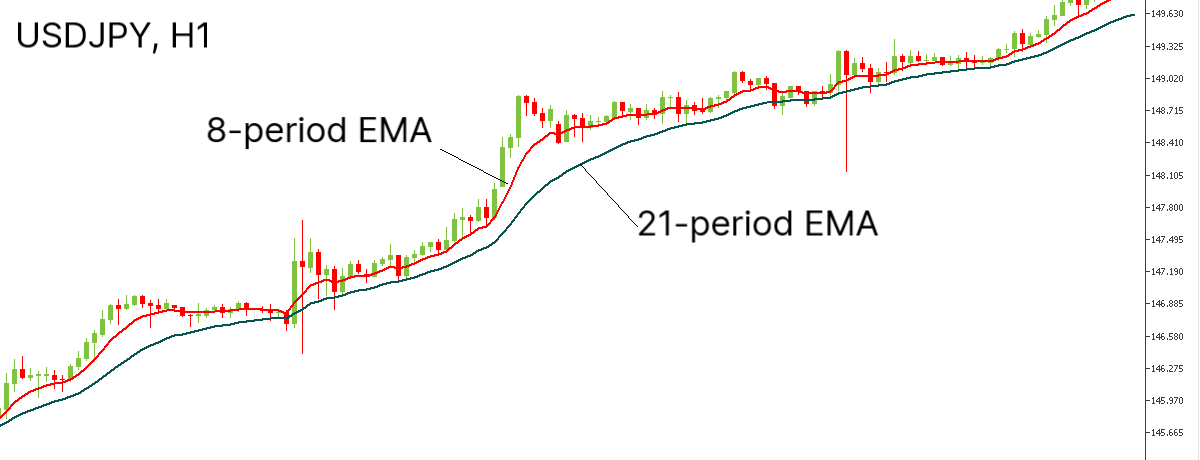
We switched to M5 and waited for the candlestick to test the 8-period EMA by its lower shadow. When the trigger candlestick occurred, we counted five candlesticks from the trigger one and chose the one with the highest high. We opened a buy position at 150.286. We placed a "buy stop" order at the high of the highest candlestick. The stop loss is placed at the low of the trigger bar at 150.271, while take profit levels go to:
149.783-149.748=0.035
TP1 = 149.783+0.035=149.818
TP2 = 149.818+0.035=149.853
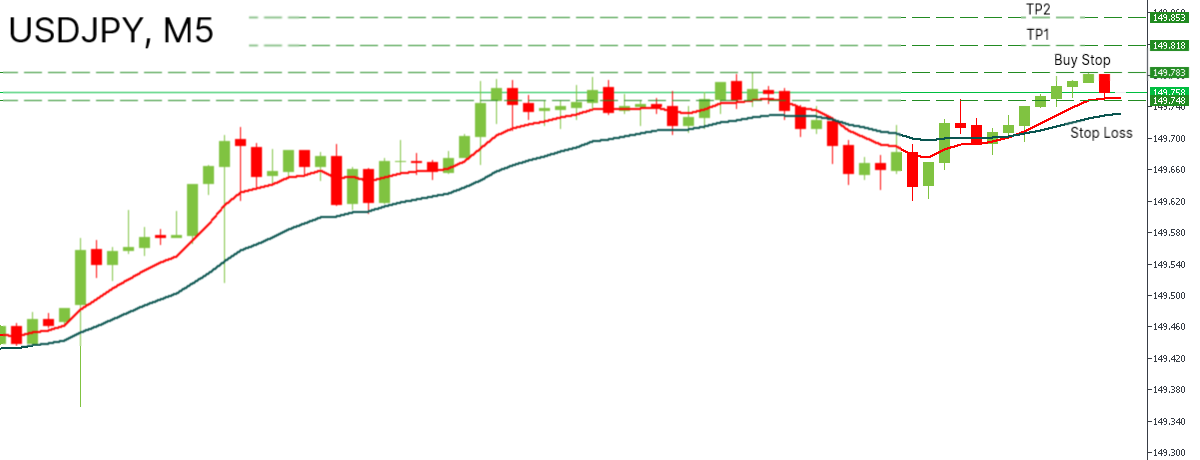
On the chart below, you can see how the trade went.
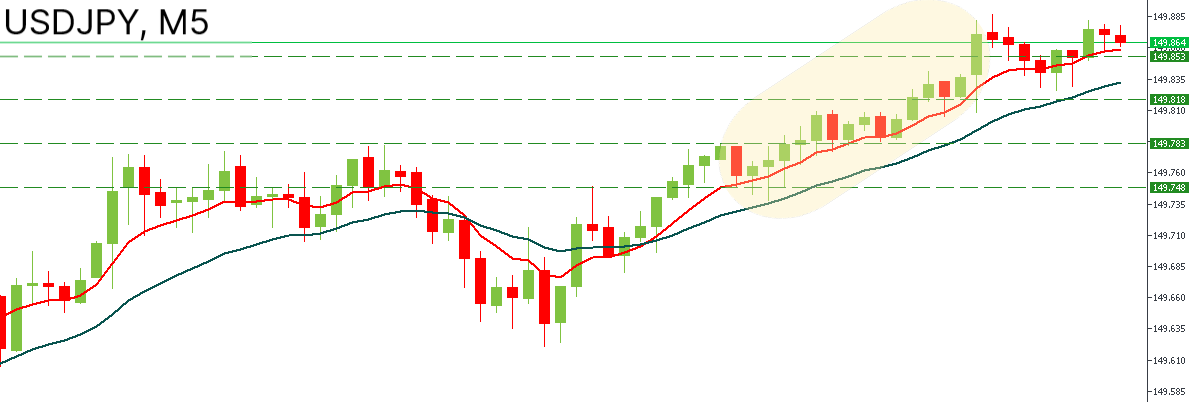
On the other hand, let’s look at the steps for opening a short position.
On the H1 chart of EURUSD, we noticed that the pair was moving within a downtrend. The 8-period EMA was moving below the 21-period EMA.

We opened the M5 chart and waited for the trigger bar. After it appeared, we counted five candlesticks from the trigger one and chose the one with the lowest low. This is our sell order which goes at 0.97525. Stop loss is placed at the high of the trigger bar at 0.97661. The take profit levels are calculated as follows:
0.97661-0.97525=0.00136
TP1 = 0.97661-0.00136=0.97389
TP2 = 0.97389-0.00136=0.97253
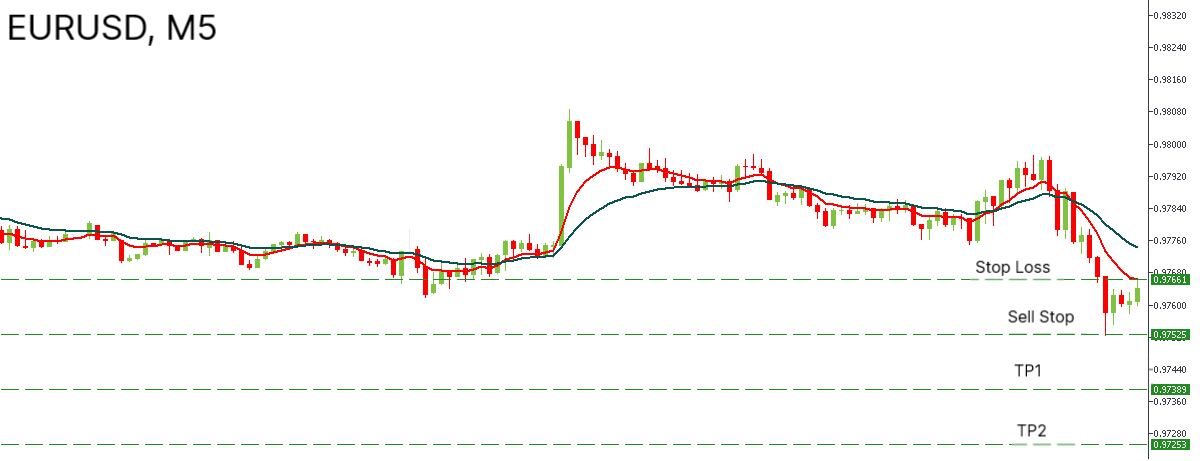
Let’s look at the sell trade.
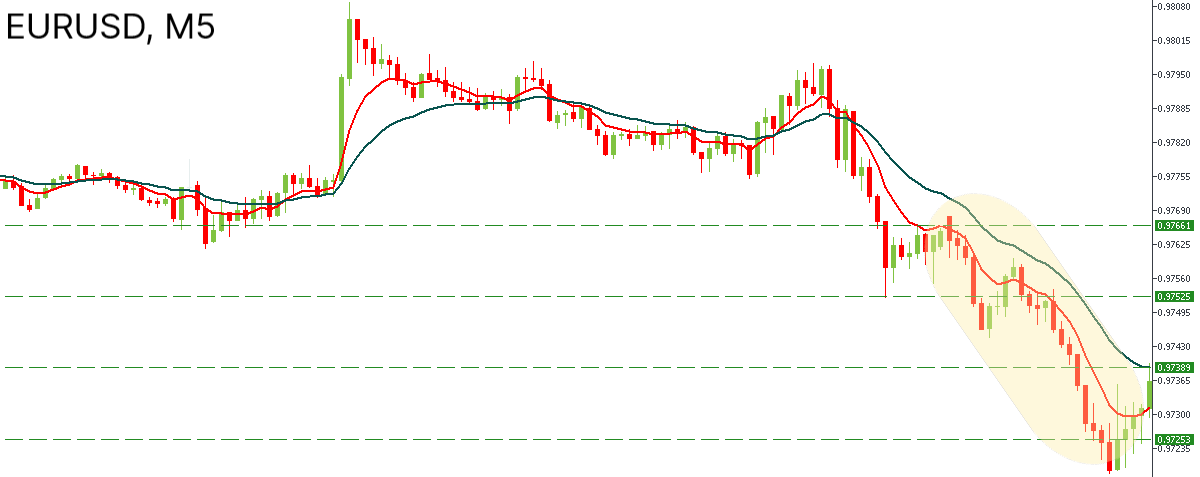
Everything worked perfectly!
The second strategy is for those who love trading gold and want to learn how to scalp precious metal. Keep in mind that it requires your full attention to the chart.
You need to buy when both slow and fast oscillators break above -30. Close your position when the fast oscillator (9) leaves the zone. Stop loss goes several points below the support level nearby.
When you consider opening a short position, you need to sell when both slow and fast oscillators break below -70 and close when the fast one leaves the zone. Stop loss is placed several points above the resistance level nearby.
Below you can see an example of a long order. We opened a position when both slow and fast oscillators were above the -30 level at 1621.16 and closed at 1625.59, when the fast oscillator crossed the -30 level to the downside. The 1619 level marks our stop loss.

As with any trading style, scalping has advantages and disadvantages. That's great if you understand them: this way, you will be entirely concerned about the risks you may face.
Scalping pros
Scalping cons
Scalping in trading is entirely legal. However, some brokers may not allow it because placing a high volume of trades in a short period may pressure broker systems. Some jurisdictions prohibit scalping, so this is another crucial point for scalpers choosing a broker. FBS has access to the ECN (Electronic Communication Network) platform through the ECN account. FBS welcomes scalpers and is ready to provide fast transaction speed, lower fees, no trading limits to maximum open positions and pending orders, and many liquidity providers. The ECN mechanism is transparent and provides brokers with comprehensive price information, which helps prevent manipulation.
Scalping may bring decent results if a trader strictly follows the trading strategy algorithm and ensures that your profit covers your costs. It's vital to backtest the trading strategy you want to use for scalping before trying it out in a real market environment.
To start scalping trading with FBS, a trader must follow four simple steps. First, they needs to choose an account. For scalping, it is recommended to select the ECN account that is available on the MT4 platform. After that, a trader needs to choose the right scalping trading strategy for him or to build their trading system. The 5-minute scalping strategy is good if a trader wants to test scalping. In the third step, it is crucial to calculate the size of a trade. Finally, a trader must choose instruments, set timeframes, and check for the news, which can affect their setup. Good luck!

Struggling to choose between part-time and full-time trading? Then this article is for you!

In trading, we can rely on a bunch of different entry signals.

A triangle chart pattern is a consolidation pattern that involves an asset price moving within a gradually narrowing range.
Click the ‘Open account’ button on our website and proceed to the Personal Area. Before you can start trading, pass a profile verification. Confirm your email and phone number, get your ID verified. This procedure guarantees the safety of your funds and identity. Once you are done with all the checks, go to the preferred trading platform, and start trading.
If you are 18+ years old, you can join FBS and begin your FX journey. To trade, you need a brokerage account and sufficient knowledge on how assets behave in the financial markets. Start with studying the basics with our free educational materials and creating an FBS account. You may want to test the environment with virtual money with a Demo account. Once you are ready, enter the real market and trade to succeed.
The procedure is very straightforward. Go to the Withdrawal page on the website or the Finances section of the FBS Personal Area and access Withdrawal. You can get the earned money via the same payment system that you used for depositing. In case you funded the account via various methods, withdraw your profit via the same methods in the ratio according to the deposited sums.
FBS maintains a record of your data to run this website. By pressing the “Accept” button, you agree to our Privacy policy.
Your request is accepted.
A manager will call you shortly.
Next callback request for this phone number
will be available in
If you have an urgent issue please contact us via
Live chat
Internal error. Please try again later
Don’t waste your time – keep track of how NFP affects the US dollar and profit!
